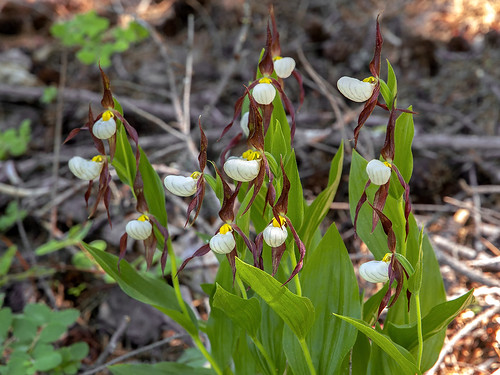As I mentioned in the previous post, the final stop on the first day of our field trips put us on top of a mountain in an area called Genesee Valley, Plumas County, California. Here we saw three orchid species: Corallorhiza maculata variety maculata or Spotted Coralroot orchid, Corallorhiza striata variety striata or Striped Coralroot orchid, and Cyprpiedium montanum or Mountain Lady’s-slipper orchid. I wanted to describe the Mountain Lady’s-slipper orchids in a separate post, since they were so lovely.
I had seen this species on a previous Native Orchid Conference field trip in Northern California/Southwestern Oregon several years ago, but I don’t think they were nearly as nice as the ones we saw and photographed in Plumas County.
Here is a close-up of one of the flowers showing the characteristic white labellum, bright yellow staminode, and dark reddish brown sepals and petals:
Although we saw the Spotted Coralroot orchids first, Raymond Prothero, our field-trip leader, guided us over to a couple of groups of Mountain Lady’s-slipper orchids just to “Wow” us. Let me tell you, it worked for me! One of the groups contained thirteen flowers — placed perfectly on the hillside above us. Note the left-most plant with three flowers on a single stem:

Another of the nearby groups contained five blooming plants — each containing two flowers on a stem:

Satisfied that he had shown us some really good stuff, Raymond told us to walk slowly down the hillside and look for the two species of Coralroot orchids and possibly more Mountain Lady’s-slipper orchids. Having gotten suitable shots of the groups of Mountain Lady’s-slipper orchids, I spent most of my time photographing the plentiful Spotted Coralroot orchids and Striped Coralroot orchids (detailed in the previous blog entry: Coralroot Orchids in Plumas County, California). Truth be known, I actually spent most of my time trying to stay upright and avoid sliding down the steep hillside and being stopped by fallen trees…Farther down the mountain, I saw another patch of Mountain Lady’s-slipper orchids in fairly good light. So I decided to try to capture some more close-ups:
 |
 |
Note the variable color in the sepals and petals within this population. The image on the left shows flowers with very dark sepals and petals, while the image on the right shows a flower with medium brownish red sepals and petals. It seems that each plant or group of plants showed a different color variation.
Here are a couple of images showing flowers with streaks and splotches of green in the sepals and petals:
 |
 |
The following image shows a flower with a particularly wide stamiode and deep, uniformly colored sepals and petals:

I could have spent a full day at this site — perfect weather, spending time with a wonderful group of orchid “nuts”, and seeing three super orchid species in large numbers. Who could ask for more? But it was time to head back, and Raymond still had a few surprises left up his sleeve…
— Jim


0 Responses
Jim:
Such wonderful orchids and beautiful photos.
Gorgeous pictures! I can see why you’re an “orchid nut” — so many different, and fascinating, varieties.